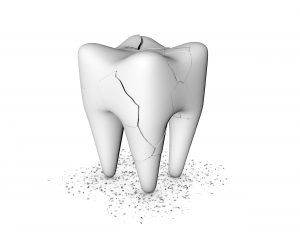There can be a number of different causes of a cracked tooth and it is important to know that many of us naturally have small cracks within our teeth, which often will never be an issue. However concerns occur when cracks cause damage to our teeth or lead to pain. 
Brightside Dental’s principal dentist Ketan discusses the subject here : https://youtu.be/TROhiFWmnkc
The main things that can cause a crack within a tooth are:
-Having a large filling which makes the rest of the tooth weaker and can cause the tooth to crack. This is generally seen more commonly with amalgam(metal fillings) compared with composite(tooth coloured) fillings because the metal is stronger than the natural tooth
-Trauma to a tooth caused by an accident or fall; sporting injury; or being involved in a fight
-Excess repeated pressure from tooth grinding (or bruxism)
-Eating particularly hard foods such as nuts, ice, hard sweets or biting into a bone
– Using your teeth for things they are not designed for such as opening bottles and tearing clothes tags
The main symptoms of a cracked tooth:
-Pain on biting or chewing that usually lasts a very short time
-Pain that comes and goes but usually doesn’t last any extended period of time
-Swelling and possible soreness of the gum around a tooth
-Sensitivity especially to hot; cold; and or sweet things
-Part of a tooth moving with pressure 
Treatment options for a cracked tooth:
Treatment will largely depend on how severe the problem is and how much the symptoms bother you. You would need to seek advice of a dentist to be able to correctly diagnose the problem and advise on the treatment options that would be suitable for you. Sometimes a cracked tooth can be very difficult to diagnose as the crack may be deep within the tooth or underneath an existing restoration so would not be visible directly in the mouth and often not on a X-ray.
- No treatment – this would be based upon the symptoms and diagnosis as to whether would be appropriate
- Composite bonding to fill and seal the crack
- Removal of existing restoration if present then to investigate the tooth and remove part of all of the crack and restore with a temporary or definitive filling and review to see if the symptoms settle
- Root canal treatment – if the crack has reached the nerve (pulp) of the tooth this may be necessary because a normal filling won’t help
- Crown. A crown may be placed either as a stand-alone treatment or following root canal treatment. The purpose of this is to protect the tooth and balance the forces on the tooth when eating
- Extraction. This may be necessary if the crack has progressed so deep within the tooth that it’s unrestorable
At Brightside Dental, we try and follow treatment in order of the above list where possible so that the least invasive treatment is carried out to resolve the problem and if it doesn’t settle, we may consider moving on to the next option. However, can’t go backwards the other way – won’t a tooth is extracted, there is no gong back!
If you would like any advice or wish to make an appointment, call us on 020 88884401.





